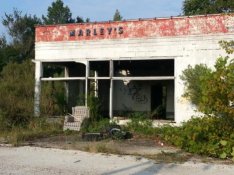bascom49
Member
- Joined
- Oct 14, 2010
- Messages
- 231
- Format
- Medium Format
This weekend I decided to spend time learning how to use my 4 x 5 camera.
Saturday I scouted out an interesting scene that I could return to for repeat exposures, loaded my film holders, and went through a few dry runs setting up my camera.
This morning I made my first exposures.
This afternoon I will develop the film make contact prints and reshoot tomorrow morning based on what I learn today.
So, given the following, how would you meter this scene ?
What developer would you use at what development time as a starting point ?
Equipment:
4x5 Cambo
Schneider 165 mm super angulon
HP5+ @ EI 400
Soligor 1 degree spot meter
Jobo processor on reel
Time and developer to be determined.
Early morning East facing scene
Spot Meter Readings:
Upper left corner of building 18
Back Wall with graffiti 15
Sky 17
Chosen apeture f32
Shutter speed determination:
Chosen shutter speed placing back wall on zone IV 1/60
Upper left corner falls on zone VII
Hopefully shadow areas fall in the range of zone II
Saturday I scouted out an interesting scene that I could return to for repeat exposures, loaded my film holders, and went through a few dry runs setting up my camera.
This morning I made my first exposures.
This afternoon I will develop the film make contact prints and reshoot tomorrow morning based on what I learn today.
So, given the following, how would you meter this scene ?
What developer would you use at what development time as a starting point ?
Equipment:
4x5 Cambo
Schneider 165 mm super angulon
HP5+ @ EI 400
Soligor 1 degree spot meter
Jobo processor on reel
Time and developer to be determined.
Early morning East facing scene
Spot Meter Readings:
Upper left corner of building 18
Back Wall with graffiti 15
Sky 17
Chosen apeture f32
Shutter speed determination:
Chosen shutter speed placing back wall on zone IV 1/60
Upper left corner falls on zone VII
Hopefully shadow areas fall in the range of zone II



 Me too.
Me too. 
